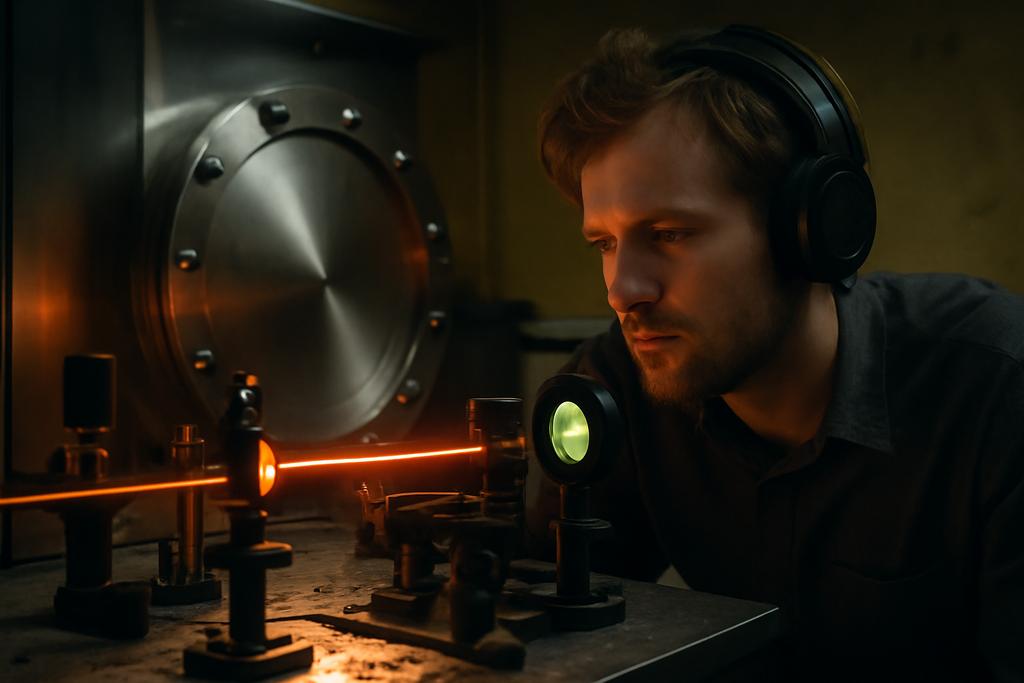Imagine the universe whispering secrets to us, its voice a faint tremor in the fabric of spacetime. These whispers are gravitational waves, ripples generated by cataclysmic events like colliding black holes. Ground-based detectors, like LIGO and Virgo, painstakingly listen for these cosmic murmurs, but their hearing is limited. A new experimental concept from researchers at the University of Hamburg, led by Nils Weickhardt, promises to sharpen that hearing significantly, potentially revealing a far richer tapestry of gravitational events.
The Limits of Listening
Current gravitational wave detectors are marvels of engineering, capable of sensing length changes smaller than the diameter of a proton. However, even these incredibly sensitive instruments are hampered by noise – unwanted vibrations and fluctuations that drown out the faint gravitational signals. One significant noise source is the control system itself, designed to isolate the detectors’ mirrors from external disturbances. These systems rely on sensors to measure the mirrors’ motion and actuators to counteract it. Think of it like a sophisticated noise-cancelling headset, constantly adjusting to neutralize unwanted sounds.
The problem is that the sensors themselves generate a level of noise. These sensors, called shadow sensors, have a fundamental sensitivity limit. This is like your noise-cancelling headphones having a faint, persistent hum – it might be quiet, but it still obscures subtle sounds.
A New Kind of Sensor
The researchers are developing a new type of sensor called the Compact Balanced Readout Interferometer (COBRI). Instead of measuring the displacement of the mirror indirectly, like the current shadow sensors, COBRI uses a laser interferometer for a more direct and precise measurement. This is like upgrading your noise-cancelling headphones from a basic model to a high-fidelity pair with advanced noise cancellation technology.
COBRI is theoretically capable of far greater sensitivity, enabling more precise control and significantly reducing the control-induced noise that limits the detectors’ performance. This technology promises to unlock a new sensitivity range, pushing the limits of gravitational wave detection into previously unexplored territory. The potential sensitivity of 10 fm/√Hz (femtometers per square root of Hertz) represents a remarkable leap forward compared to the current 1–0.04 nm/√Hz of existing shadow sensors.
Putting COBRI to the Test
To validate COBRI’s potential, the researchers designed a sophisticated experiment involving two highly sensitive HAM Relay Triple Suspension (HRTS) systems, temporarily provided by the ET Pathfinder project. These suspensions are used in LIGO and are designed to isolate the mirrors. COBRIs will be mounted onto these systems, directly comparing their performance with the existing BOSEM sensors used in LIGO. Essentially, they’re conducting an A/B comparison, measuring the length stability of an optical cavity created between two suspended mirrors with both COBRIs and BOSEMs in tandem. This precise measurement will gauge the effectiveness of the COBRI’s active damping capabilities against the existing standard.
The researchers have developed sophisticated simulations of the experiment to model various noise sources and predict COBRI’s performance. These simulations account for factors like seismic noise (ground vibrations), thermal noise (random motion of atoms in the suspension materials), and quantum noise (fundamental limitations imposed by quantum mechanics). The modeling utilizes Mathematica, spicypy, and other sophisticated tools originally designed for use in LIGO.
The Challenges and the Promise
The simulations reveal that while the COBRI is expected to show an improvement, the current level of seismic isolation in the experimental setup is a limiting factor. The experiment is located inside an actively isolated vacuum chamber on a passive table. While this setup helps mitigate seismic noise, further improvements in isolation are crucial for fully realizing the sensor’s potential. The researchers aim to achieve a significant reduction in seismic noise – one to two orders of magnitude – to reach a point where the sensor noise, rather than seismic noise, is the dominant limiting factor.
This improvement is like going from listening to a concert in a noisy stadium to listening in a quiet recording studio. Reducing the background hum will allow them to hear a much wider range of frequencies.
Further refining the suspension mechanics could also enhance COBRI’s performance. They are looking at modifying the existing suspension design to enhance the coupling between the sensor and the test masses. This improvement would help amplify the effect of the sensor’s superior sensitivity, making the difference in performance more pronounced. This is akin to improving the quality of your microphone to better capture those fainter sounds.
The Future of Gravitational Wave Astronomy
The work presented by Weickhardt and colleagues offers a glimpse into the future of gravitational wave astronomy. By reducing control noise, COBRI could pave the way for significantly more sensitive detectors. This enhanced sensitivity could unveil a treasure trove of new gravitational wave signals, allowing us to probe the universe’s most violent and mysterious phenomena in unprecedented detail. The ability to detect a wider range of signals would allow for improved sky localization and assist in the observation of electromagnetic and particle signals emitted during significant gravitational events, such as merging neutron stars.
The next generation of gravitational wave detectors, including the ambitious Cosmic Explorer and Einstein Telescope projects, will require even higher sensitivity to achieve their scientific goals. COBRI and similar interferometric sensors could play a crucial role in enabling these future observatories to hear the whispers of the universe with unprecedented clarity.










